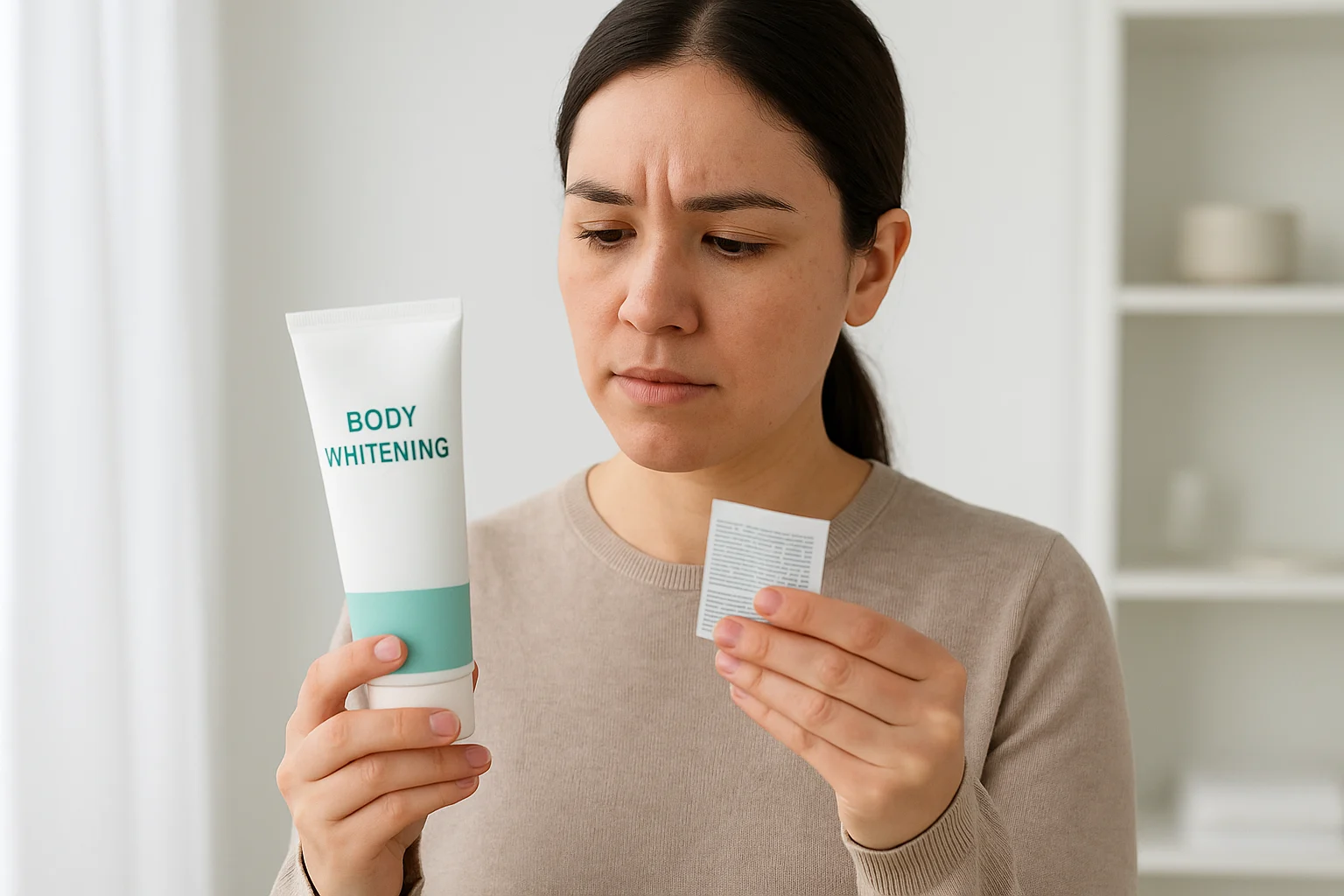Wanting even-toned skin is normal. If you’ve got darker areas on your knees, underarms, or around your neck, you’ve probably thought about trying a body whitening cream or treatment. But the question is simple — is it safe?
What is body whitening, and why do people do it?
Body whitening means using products or treatments to lighten skin by reducing melanin. People with dark skin or spots often try it to even out their tone or lighten specific areas.
Melanin is what gives skin its colour. The more you’ve got, the darker your skin is. That’s not a bad thing. It’s just biology. But sometimes, certain parts of your body become darker than the rest. That could be from friction, shaving, sun damage, hormones, or genetics.
This is where body whitening comes in. People use it to fade dark spots, lighten underarms, or reduce pigmentation caused by acne or scarring. It’s not about changing who you are. It’s about wanting your skin to feel smooth and look even.
Still, the line between harmless skin care and harmful bleaching is thin. That’s why you’ve got to know what works and what’s risky.
Body whitening treatments and their risks
There’s more than one way to lighten your skin. Some options are quick, some are slow, and some aren’t worth touching. Let’s break them down.
Creams and lotions
These are the most common. You’ll find hundreds of these online or at beauty shops. Some have natural ingredients like niacinamide, kojic acid, or liquorice extract. Others come with serious chemicals.
Here’s the deal — if the label has hydroquinone, mercury, or potent steroids, skip it. These can cause rashes, thin your skin, or worsen the dark patches later. Mercury mainly builds up in your body and damages your kidneys. And it doesn’t go away easily.
Even when creams look safe, always patch test first. Apply a small amount to your arm and wait 24 hours. If there’s no reaction, you can continue.
Chemical peels
Peels work by removing the top layer of your skin. They use acids like glycolic or lactic acid to shed dead cells and bring fresh skin to the surface. This can make skin look brighter and help with patchy areas.
But if you’re not careful or you get the wrong strength, you can burn your skin. Darker skin tones are also more likely to develop post-inflammatory hyperpigmentation, which means your skin can get darker after peeling. So always get peels done by a trained dermatologist.
Laser treatments
Lasers target pigment and break it down. They are used for dark spots, melasma, and uneven tone. They can give faster results than creams, but they cost more.
The problem is that lasers don’t work the same for everyone. On dark skin, the wrong laser or setting can cause burns or make spots worse. So, if you’re thinking of this, find someone who’s treated dark skin before. Not every clinic has the right tools or training.
Glutathione injections
This one’s trending online. Glutathione is an antioxidant your body already makes. Some clinics now offer it as an injection or drip to lighten skin from the inside.
Sounds easy, but here’s the catch — there’s no solid proof it works, and there’s no control over the dose. Injecting something straight into your bloodstream without proper approval is risky. Side effects can include kidney issues, thyroid problems, or infections if the equipment isn’t clean.
Some countries have banned it for a reason. If you still want to try it, ask a real doctor, not just someone promoting it on Instagram.
Safer ways to deal with skin concerns
You don’t need to change your skin tone to feel good about yourself. There are other ways to improve your skin’s look and feel without risking your health.
Focus on healthy skin, not lighter skin.
Bright skin isn’t the same as light skin. When your skin is clean, hydrated, and cared for, it glows, and that glow has nothing to do with colour.
Use gentle cleansers, exfoliate once or twice a week, and apply sunscreen daily—yes, even if you have dark skin. Sun damage causes uneven tone and worsens spots.
Drink enough water and eat more fruits. Your skin reflects what you eat and how you live. Don’t expect a cream to do everything if the basics are missing.
Treat specific spots, not your whole body.
If your underarms or knees are darker than the rest, treat those areas only. You don’t need to bleach your whole body. Try natural brighteners like niacinamide, turmeric-based creams, or aloe vera gels.
Use moisturiser often, especially on rough areas. Dry skin looks dull and darker. Keeping it soft makes a big difference over time.
Stop what’s causing the dark spots.
Sometimes it’s not about adding a new product but removing the bad habit. If you shave with a dull razor, switch to a cleaner method. If your clothes rub too much, try looser fits. If you pick at your skin, learn to stop.
Solving the root cause means you won’t have to fight the same spots repeatedly.
Final thoughts
Body whitening can feel tempting, especially when ads promise fast changes or filters make every photo look smooth. But your skin is an organ, not a canvas. It needs care, not shortcuts.
Some creams and treatments work, but many come with risks. You should never trust a product without a clear label or one that promises instant results. That’s usually a trap.
Stick with ingredients known to be safe. Use sunscreen. And if you’re dealing with stubborn spots, see a real dermatologist. They won’t just guess — they’ll figure out what your skin needs.
You don’t have to change your skin tone to look good. You need skin that’s healthy, clean, and cared for. That’s what makes you glow.

